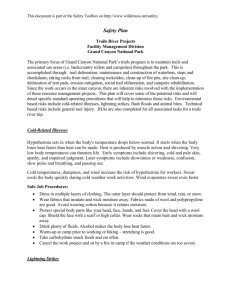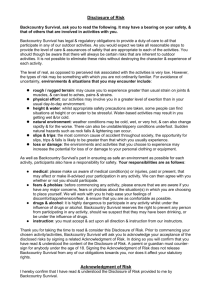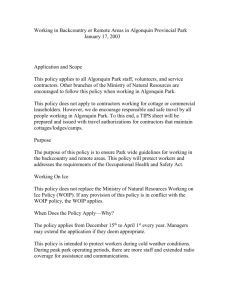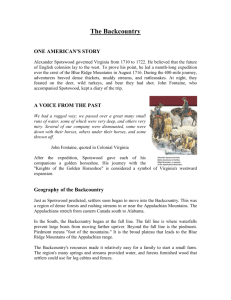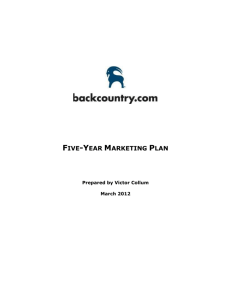Backcountry Travel Job Safety Analysis (JSA)
advertisement
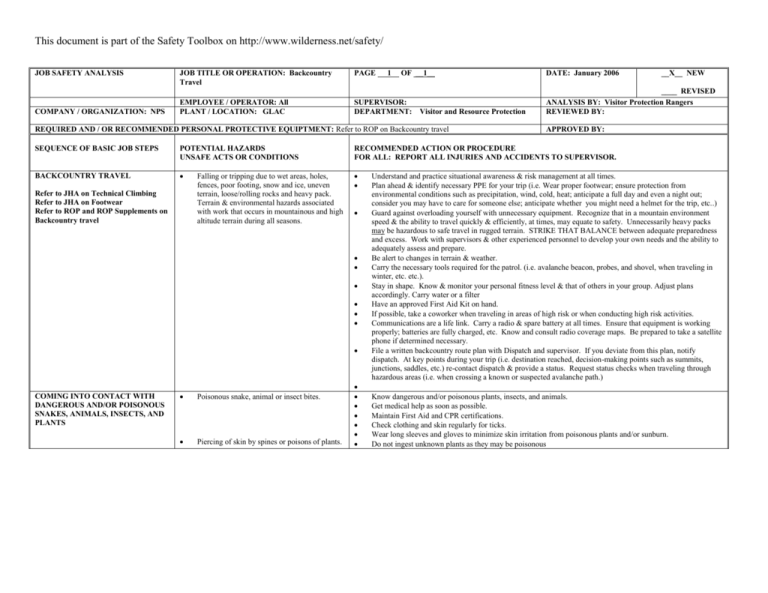
This document is part of the Safety Toolbox on http://www.wilderness.net/safety/ JOB SAFETY ANALYSIS COMPANY / ORGANIZATION: NPS JOB TITLE OR OPERATION: Backcountry Travel PAGE 1 OF __1__ EMPLOYEE / OPERATOR: All PLANT / LOCATION: GLAC SUPERVISOR: DEPARTMENT: Visitor and Resource Protection REQUIRED AND / OR RECOMMENDED PERSONAL PROTECTIVE EQUIPTMENT: Refer to ROP on Backcountry travel DATE: January 2006 ____ REVISED ANALYSIS BY: Visitor Protection Rangers REVIEWED BY: APPROVED BY: SEQUENCE OF BASIC JOB STEPS POTENTIAL HAZARDS UNSAFE ACTS OR CONDITIONS RECOMMENDED ACTION OR PROCEDURE FOR ALL: REPORT ALL INJURIES AND ACCIDENTS TO SUPERVISOR. BACKCOUNTRY TRAVEL Refer to JHA on Technical Climbing Refer to JHA on Footwear Refer to ROP and ROP Supplements on Backcountry travel Falling or tripping due to wet areas, holes, fences, poor footing, snow and ice, uneven terrain, loose/rolling rocks and heavy pack. Terrain & environmental hazards associated with work that occurs in mountainous and high altitude terrain during all seasons. COMING INTO CONTACT WITH DANGEROUS AND/OR POISONOUS SNAKES, ANIMALS, INSECTS, AND PLANTS Poisonous snake, animal or insect bites. Piercing of skin by spines or poisons of plants. __X__ NEW Understand and practice situational awareness & risk management at all times. Plan ahead & identify necessary PPE for your trip (i.e. Wear proper footwear; ensure protection from environmental conditions such as precipitation, wind, cold, heat; anticipate a full day and even a night out; consider you may have to care for someone else; anticipate whether you might need a helmet for the trip, etc..) Guard against overloading yourself with unnecessary equipment. Recognize that in a mountain environment speed & the ability to travel quickly & efficiently, at times, may equate to safety. Unnecessarily heavy packs may be hazardous to safe travel in rugged terrain. STRIKE THAT BALANCE between adequate preparedness and excess. Work with supervisors & other experienced personnel to develop your own needs and the ability to adequately assess and prepare. Be alert to changes in terrain & weather. Carry the necessary tools required for the patrol. (i.e. avalanche beacon, probes, and shovel, when traveling in winter, etc. etc.). Stay in shape. Know & monitor your personal fitness level & that of others in your group. Adjust plans accordingly. Carry water or a filter Have an approved First Aid Kit on hand. If possible, take a coworker when traveling in areas of high risk or when conducting high risk activities. Communications are a life link. Carry a radio & spare battery at all times. Ensure that equipment is working properly; batteries are fully charged, etc. Know and consult radio coverage maps. Be prepared to take a satellite phone if determined necessary. File a written backcountry route plan with Dispatch and supervisor. If you deviate from this plan, notify dispatch. At key points during your trip (i.e. destination reached, decision-making points such as summits, junctions, saddles, etc.) re-contact dispatch & provide a status. Request status checks when traveling through hazardous areas (i.e. when crossing a known or suspected avalanche path.) Know dangerous and/or poisonous plants, insects, and animals. Get medical help as soon as possible. Maintain First Aid and CPR certifications. Check clothing and skin regularly for ticks. Wear long sleeves and gloves to minimize skin irritation from poisonous plants and/or sunburn. Do not ingest unknown plants as they may be poisonous WORKING IN ADVERSE WEATHER Getting struck by lightning. Schedule outdoor activities accordingly if thunderstorms are likely. If you see or hear a thunderstorm coming, go inside a sturdy building or vehicle. You are in danger from lightning if you can hear thunder. Carry a pack or insolating pad if you are not working near a building or vehicle. If you are caught in a lightning storm, call dispatch to tell them you will be out of radio contact until the lightning storm passes. Call back in after the storm has passed. If you can’t get inside and if you feel your hair stand on end, lightning is about to strike. Crouch down on your pack or insolating pad on the balls of you feet and keep your feet close together. Place your hands on your knees and lower your head. Make yourself the smallest target possible and minimize contact with the ground. Members of a party should stay separated by at least ten feet. Stay away from tall things like trees, towers, fences, telephone lines, or power lines. Stay away from high mountain passes and high open meadows. If caught in these areas rapidly descend to a heavily forested area, however, stay at least 8 feet away from the trunk of the average height tree. Stay away from metal things that lightning may strike. Stay away from running water. Call for help on your radio or on the nearest phone; be prepared to give detailed information of the victim or victims status, and when and where the accident happened. Administer First Aid and CPR if certified or instructed to do so. Take a Backcountry First Aid and CPR Class. BACKCOUNTRY MISC. Exposure. Be alert to changes in weather. Take adequate garments for all possible weather conditions. Take a coworker when traveling in extreme mountain weather. Heat Stroke. Drink adequate amounts of water. Water borne illnesses Filter all water Hantivirus Use precautions around buildings and other infested areas Stock Use Take care around stock animals. Attend training. Use caution at all times. Don’t work above you skill level Dangerous wildlife Always make noise while hiking. Carry bear spray and radio at all times. Attend wildlife training. Power and hand tools Use proper safety gear. Get proper training and instructions on safe use. Use minimum tool necessary. Heavy lifting Get assistance with heavy items. Use proper form and techniques for lifting Bear Spray Know first aid treatment for exposure. Be aware of wind conditions while traveling Firearms Know the firearms safety rules and always follow them. Solo travel Take extra precautions when traveling solo. Always be aware of you surroundings and possible problems Helicopter Follow guidelines for helicopter safety. Oversnow travel Receive training for snow and ice travel conditions and/or equipment. Never overestimate your ability. Vehicles and trailers Receive proper training for vehicles and trailers. Always check vehicle or trailer conditions before each use.

